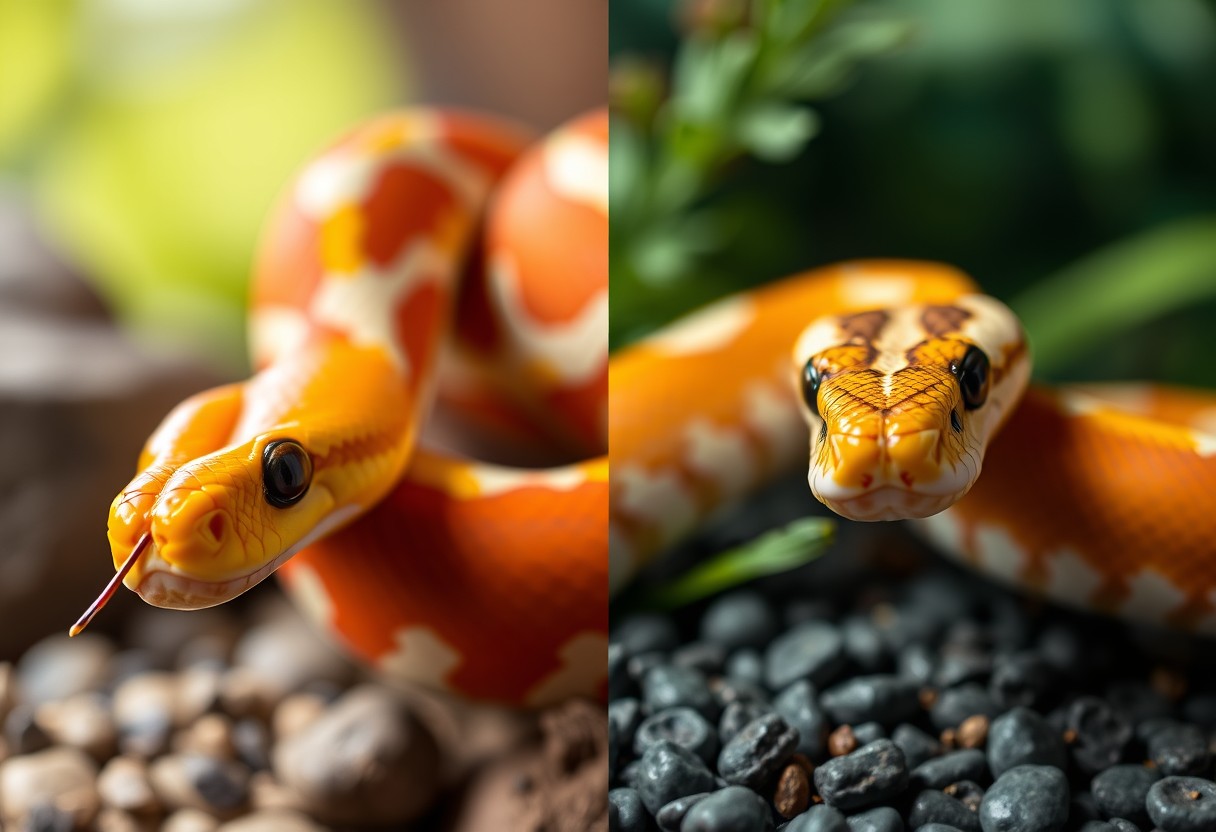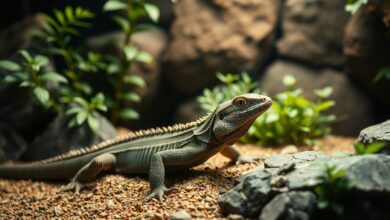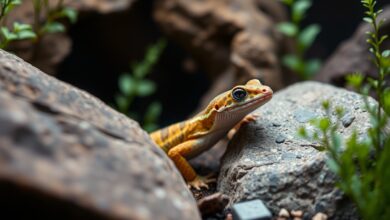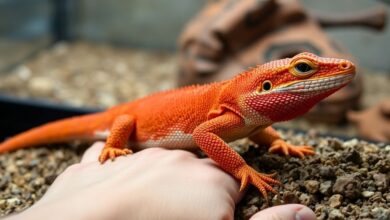Corn Snake vs Milk Snake – 8 Differences in Care and Appearance

Most enthusiasts find themselves torn between keeping a Corn Snake or a Milk Snake as their pet, given their unique features and care requirements. Understanding the key differences in appearance and care for these two popular snake species is vital for making an informed decision for your collection. Whether you’re a beginner or a seasoned keeper, knowing how to meet their specific needs will lead to a healthier and more rewarding experience for both you and your snake. Dive into this guide to explore the 8 main differences you should consider.
Key Takeaways:
- Appearance: Corn snakes typically have a more muted color palette, while milk snakes display vibrant patterns and colors.
- Care Requirements: Corn snakes generally require more humidity in their habitat compared to milk snakes, which prefer drier environments.
- Temperament: Corn snakes are often considered more docile and easier to handle, while milk snakes can be more defensive and may hiss when threatened.
Appearance: Color and Patterns
Ample variation in color and pattern makes both the Corn Snake and Milk Snake standout choices for reptile enthusiasts. While each species boasts its unique traits, their dazzling hues and striking designs contribute significantly to their appeal. By understanding these characteristics, you can better assess which snake fits your preferences and requirements.
Corn Snake Characteristics
By observing Corn Snakes, you’ll notice their vibrant banding and varied color patterns. These snakes typically showcase shades of orange, red, yellow, and brown, enhancing their striking appearance. Often adorned with dark saddle-shaped markings along their back, they exhibit an impressive contrast that makes them visually captivating.
Milk Snake Characteristics
Around Milk Snakes, you will find an array of colors, including black, red, and white or cream. Their distinct tricolor pattern typically consists of bright red bands bordered by black and white sections, making them visually stunning. This bold coloration can sometimes lead to confusion with venomous Coral Snakes, so awareness is crucial.
It is important to note that while Milk Snakes possess a striking appearance, their coloration can vary widely depending on the region. Some may display more muted tones, while others flaunt brilliant combinations. Non-venomous and generally quite manageable, these snakes make excellent pets, being both beautiful and typically easy to care for. Nonetheless, their vibrant patterns serve a purpose; they help them blend into their environment, providing effective camouflage against predators. Understanding these characteristics will aid you in making an informed decision regarding your next pet snake.
Size and Growth Rate
Assuming you are considering keeping either a corn snake or a milk snake, it’s important to understand their size differences and growth rates. Corn snakes generally grow larger, reaching lengths of 4 to 5.5 feet, while milk snakes usually stay around 2 to 4 feet. This size discrepancy can influence your choice in habitat setup, as corn snakes will require more space to thrive as they grow.
Growth Patterns of Corn Snakes
Before acquiring a corn snake, it’s important to know that they grow rapidly in their first year, reaching lengths of 2 to 3 feet. As they mature, their growth begins to slow, stabilizing around their adult size by the age of 3 to 5 years. Proper husbandry, including diet and environmental conditions, significantly impacts their growth rate.
Growth Patterns of Milk Snakes
Growth is slightly different for milk snakes; they will generally reach their adult size more slowly compared to corn snakes. In their first year, milk snakes can grow to about 1.5 to 2 feet long, with their growth slowing down as they mature. They typically reach adult sizes within 3 to 4 years of age, making their growth a more gradual process.
Rate of growth for milk snakes is influenced by several factors, including diet, enclosure size, and temperature. It’s vital that you provide adequate space and nutrition to facilitate healthy growth. Unlike corn snakes, milk snakes may exhibit more variation in size due to their different geographic subspecies. As a keeper, you’ll need to be aware of these factors to ensure your milk snake achieves its optimal size without any growth-related health issues.

Habitat and Enclosure Requirements
Not all habitats are created equal when it comes to keeping a corn snake or a milk snake. Understanding the differences in their needs is vital for proper care. For a deeper insight into this topic, check out What’s the difference between an eastern milk snake and a corn snake.
Corn Snake Habitat
Behind the scenes, corn snakes thrive in a well-ventilated enclosure that mimics their natural grassland habitat. Aim for a minimum size of 20 gallons, equipped with a secure lid, ample hiding spots, and climbing branches to satisfy their curiosity and need for exploration.
Milk Snake Habitat
Snake enthusiasts will find that milk snakes prefer a habitat that closely resembles their native forested and rocky surroundings. An enclosure of at least 30 gallons will not only accommodate their longer bodies but also allow for the crucial hides, climbing implements, and appropriate substrate for burrowing.
Hence, investing in the right habitat is vital for your milk snake’s wellbeing. Provide suitable humidity levels and temperature gradients to ensure your pet stays healthy and active. Ensure that the enclosure has secure hides where your snake can feel safe, as this mimics the natural environment. Regular maintenance of substrate and access to fresh water will keep your snake thriving.

Diet and Feeding Habits
To ensure your snake remains healthy, it is vital to understand the differences in diet and feeding habits between corn snakes and milk snakes. Each species has specific nutritional needs that you must cater to, regardless of their appealing appearance. Knowing how to appropriately feed your snake can contribute significantly to its overall well-being.
Corn Snake Diet
An adult corn snake primarily feeds on rodents, such as mice and rats. You should provide appropriately sized prey, which is usually about the same width as the snake’s widest part. Young corn snakes may consume pinky mice, while adults can handle larger prey, ensuring the feeding schedule aligns with your snake’s growth and activity levels.
Milk Snake Diet
Diet for milk snakes is similarly straightforward and involves feeding them small rodents, though they may also consume lizards and occasionally, birds.
In fact, milk snakes can vary their diet depending on their habitat and availability of prey, showcasing their adaptability in the wild. Providing a variety of appropriately sized food is vital for their health, and it’s best to offer prey that matches their age and size. Keep in mind that overfeeding can lead to obesity, while inadequate nourishment will stunt their growth. Regular feeding patterns along with proper prey selection are vital for your milk snake’s development and overall vitality.

Temperament and Behavior
Your choice between a corn snake and a milk snake can significantly affect your experience as a snake owner. Both species have unique temperaments and behavioral traits that cater to different types of snake enthusiasts. For insights, you can check out this discussion on Milk snake vrs corn snake for first snake? : r/snakes.
Corn Snake Behavior
Against popular belief, corn snakes are typically known for their docile and calm demeanor, which makes them excellent companions for beginners. They are often more inclined to be handled regularly and will likely tolerate being taken out of their enclosures without much fuss.
Milk Snake Behavior
Any novice snake owners might find milk snakes slightly more challenging due to their sometimes skittish nature. They are naturally curious and adventurous, which can lead them to explore their environments more actively than corn snakes.
Understanding the nuances of milk snake behavior is imperative for proper care. Though they can display a more elusive temperament, these snakes are still highly interactive and intelligent. It’s important to approach them with patience, as they might exhibit quick movements if startled. Their diet involves a variety of prey, so maintaining a proper feeding schedule is also key. With time and gentle handling, you can help them feel secure and build a trusting bond.
Health Concerns and Lifespan
After understanding the differences in care and appearance between corn snakes and milk snakes, it’s vital to consider their health concerns and expected lifespan. Both species can thrive under proper conditions, but each has specific health challenges that can affect their longevity and quality of life. Typically, corn snakes live between 15 to 20 years, while milk snakes can also reach similar lifespans, given appropriate care.
Common Health Issues for Corn Snakes
For corn snakes, respiratory infections and mites are common health concerns. These can arise from inadequate humidity levels or unsanitary living conditions. Providing a stable environment and regular health checks can help you avoid these issues and keep your pet thriving.
Common Health Issues for Milk Snakes
Common health concerns for milk snakes include skin shedding problems and gastrointestinal issues. These tend to result from improper humidity and temperature, highlighting the need for optimal habitat conditions.
Common issues related to skin shedding often lead to retained shed, which can cause stress and discomfort for your milk snake. Maintaining proper humidity levels is vital, as dry conditions increase the likelihood of this issue. In addition, gastrointestinal problems may arise from improper feeding or temperate fluctuations. Providing a balanced diet and consistent environmental conditions can significantly improve your snake’s health and overall well-being.
Conclusion
With this in mind, understanding the differences in care and appearance between corn snakes and milk snakes allows you to make an informed choice for your pet. While both species are fascinating, your decision may depend on factors like habitat, diet, and temperament. By evaluating these aspects, you can ensure that you select the snake that best fits your lifestyle and preferences. Whether you choose a corn snake or a milk snake, you’re sure to enjoy the beauty and companionship these reptiles offer.
Q: What are the main differences in habitat requirements between Corn Snakes and Milk Snakes?
A: Corn Snakes prefer a dry environment with a substrate that retains minimal moisture, such as aspen shavings or paper towels. They thrive in temperatures between 75-85°F (24-29°C) and benefit from a basking area that reaches around 88-92°F (31-33°C). On the other hand, Milk Snakes require slightly higher humidity levels, often around 40-60%, and benefit from a substrate that maintains some moisture, such as coconut fiber or cypress mulch. Their temperature needs are similar but can tolerate higher basking temperatures, up to 90°F (32°C).
Q: How do the feeding habits of Corn Snakes differ from those of Milk Snakes?
A: Corn Snakes are primarily rodent eaters and are typically fed thawed mice or rats, which should be appropriately sized relative to the snake’s girth. They usually eat every 7-10 days. Conversely, Milk Snakes have a more varied diet and can consume a wider range of prey, including lizards, amphibians, and small mammals, depending on their age and size. Like Corn Snakes, Milk Snakes eat every 7-10 days, but it is important to tailor their diet to include different prey types to ensure nutritional balance.
Q: What differences can be seen in the appearance of Corn Snakes compared to Milk Snakes?
A: Corn Snakes typically have a more subdued coloration with a pattern of orange, yellow, or brown, featuring dark brown or black markings along their bodies. They often display a checkerboard pattern on the underside. In contrast, Milk Snakes showcase vibrant and varied color patterns, including red, black, and yellow bands, giving them a strikingly bold appearance. Moreover, Milk Snakes often have a more slender body compared to the stockier build of Corn Snakes, making them visually distinct.





